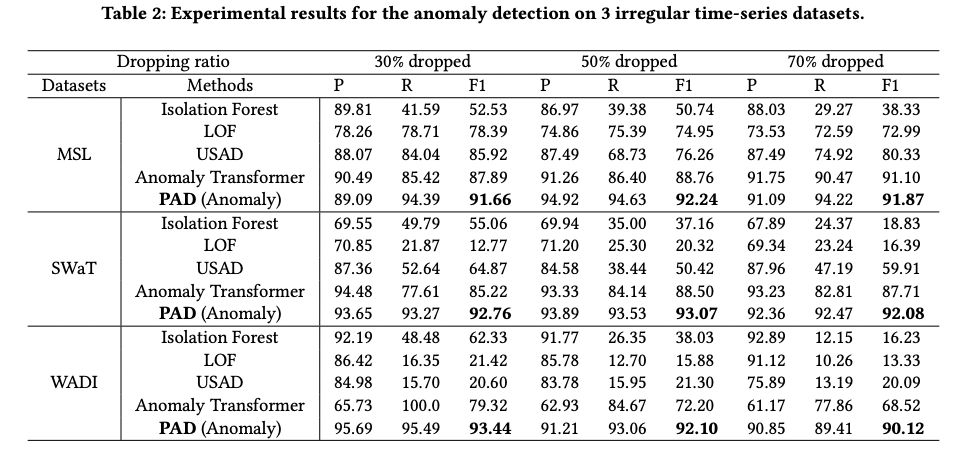Precursor-of-Anomaly Detection for Irregular Time Series
https://arxiv.org/pdf/2306.15489
Contents
- Abstract
- Introduciton
- Preliminaries
- Proposed Methods
- Problem statement
- Overall workflow
- NN based on co-evolving NCDEs
- Training algorithm
- Experiments
- Regular TS
- Irregular TS
Abstract
Precursor-of-Anomaly (PoA) detection.
- Propose a novel type of AD
(Conventional) AD vs. PoA
- (Conventional) AD: Focuses on determining whether a **GIVEN time series ** is anomaly
- PoA: Focuses on determining whether a **FUTURE time series ** is anomaly
Proposed algorithm: Neural controlled differential equation-based NN
1. Introduction
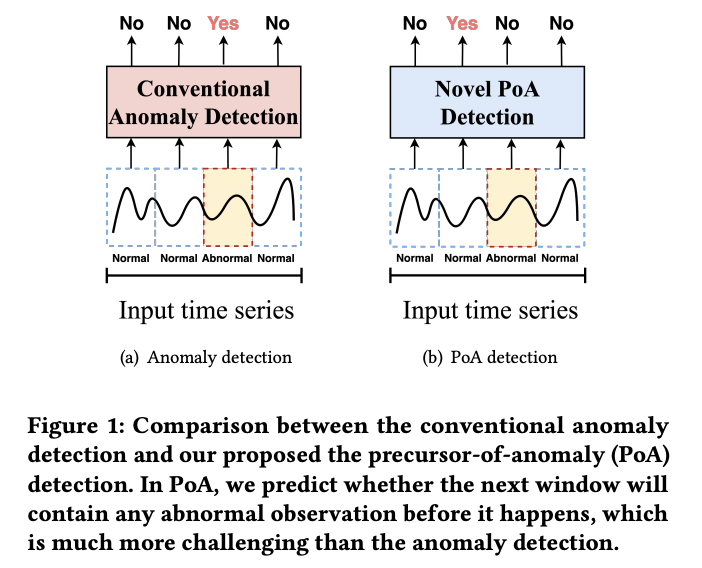
Contributions
- First to solve both AD & PoA
- Propose PAD (NCDE-based unified framework)
- Design a (1) multi-task & (2) knowledge distillation learning method
-
Self-supervised learning (SSL)
- Propose an augmentation method to create artificial anomalies for SSL
- Regular & Irregular TS experiments + Code provided
- https://github.com/sheoyon-jhin/PAD
2. Preliminaries
Differential equations
- Neural Ordinary Differential Equations (NODE)
- Neural Controlled Differential Equations (NCDE)
NODE vs. NCDE
- NODE:
- \(\mathbf{z}(T)=\mathbf{z}(0)+\int_0^T f\left(\mathbf{z}(t), t ; \theta_f\right) d t\).
- NCDE:
- \(\begin{aligned} z(T) & =z(0)+\int_0^T f\left(z(t) ; \theta_f\right) d X(t) \\ & =z(0)+\int_0^T f\left(z(t) ; \theta_f\right) \frac{d X(t)}{d t} d t \end{aligned}\).
3. Proposed Methods
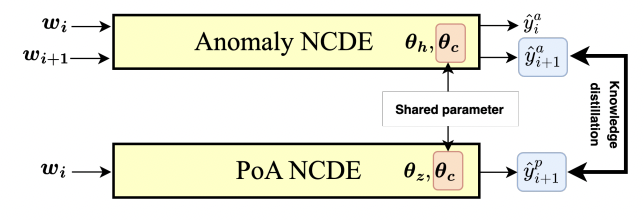
(1) Problem statement
Notation & Settings
- MTS: \(\mathbf{x}_{0: T}=\left\{\mathbf{x}_0, \mathbf{x}_1, \ldots, \mathbf{x}_T\right\}\), where., \(\mathbf{x}_t \in \mathbb{R}^N\).
- (Irregular TS) Time-interval between two consecutive observations is not a constant
- (Regular TS) Time0interval is fixed
- Window-based approach
- \(x_{0:T}\) is divided into non-overlapping windows
- i.e., \(w_i=\) \(\left[\mathbf{x}_{t_0^l}, \mathbf{x}_{t_i^l}, \ldots, \mathbf{x}_{t_b^l}\right]\) where \(t_j^i=i \times b+j-1\) with a window size of \(b\).
- \(\left\lceil\frac{T}{b}\right\rceil\) windows in total for \(x_{0, T}\).
- \(x_{0:T}\) is divided into non-overlapping windows
Task: For a given input window \(w_i\), …
- (AD) Decides whether \(w_i\) contains abnormal observations
- (PoA) Decides whether \(w_{i+1}\) contains abnormal observations
(Both are binary classification tasks)
(2) Overall workflow
-
(1) SSL
- Create augmented training data
-
(2) Two co-evolving NCDE layers
- Produce the last hidden representations \(\mathbf{h}(T)\) and \(\mathbf{z}(T)\)
-
(3) Training stage: Anomaly NCDE gets two inputs:
- \(w_i\) for the anomaly detection
- \(w_{i+1}\) for the PoA detection
-
(4) Two output layers:
- For the anomaly detection
- For the PoA detection
\(\rightarrow\) These two different tasks are integrated into a single training method!
- (Multi-task learning) Shared parameter \(\theta_c\)
-
(5) Two outputs:
- Creates the two outputs \(\hat{y}_i^a\) and \(\hat{y}_{i+1}^a\) for the knowledge distillation
(3) NN based on Co-evolving NCDEs
Dual co-evolving NCDEs
- (1) One for the AD
- (2) One for PoA
[Preprocessing step]
Given a discrete TS sample \(\mathbf{x}_{1: T}\)….
\(\rightarrow\) Create a continuous path \(X(t)\) using an interpolation method
[Co-evolving NCDEs]
- Obtain two hidden vectors \(h(T)\) and \(z(T)\)
- \(\mathbf{h}(T)=\mathbf{h}(0)+\int_0^T f\left(\mathbf{h}(t) ; \theta_f, \theta_c\right) \frac{d X(t)}{d t} d t\).
- \(\mathbf{z}(T)=\mathbf{z}(0)+\int_0^T g\left(\mathbf{z}(t) ; \theta_g, \theta_c\right) \frac{d X(t)}{d t} d t\).
(Multi-task) Architecture details:
- \(f\left(\mathrm{~h}(t) ; \theta_f, \theta_e\right) =\underbrace{\rho(\mathrm{FC}(\phi(\mathrm{FC}(\mathrm{~h}(t)))))}_{\theta_f}+\underbrace{\rho(\mathrm{FC}(\phi(\mathrm{FC}(\mathrm{~h}(t)))))}_{\theta_0}\).
- \(g\left(z(t) ; \theta_g, \theta_e\right) =\underbrace{\rho(\mathrm{FC}(\phi(\mathrm{FC}(z(t)))))}_{\theta_0}+\underbrace{\rho(\mathrm{FC}(\phi(\mathrm{FC}(z(t)))))}_{\theta_0}\).
- \(\phi\): ReLU
- \(\beta\) : Tanh
- Note that two NCDEa co-evolve by using the shared params \(\theta_c\)
Output layers:
- (For AD) \(y_i^e=\sigma(F C_{\theta_0}(h(T))\)
- (For PoA) \(S_i^f=\sigma\left(F C_{\theta_p}(z(T))\right)\).
(4) Training Algorithm
Loss function: (CE loss)
- \(L_{K D D}=C E\left(\hat{\rho}_{i+1}^a+\hat{\rho}_{i+1}^p\right)\).
- \(\hat{y}_{i+1}^a\) : Anomaly NCDE model’s output
- \(\hat{y}_{i+1}^p\): PoA NCDE model’s output
- \(L_a=C E\left(\hat{y}_i^a, y_i\right)\).
- \(y_i\): GT of anomaly detection.
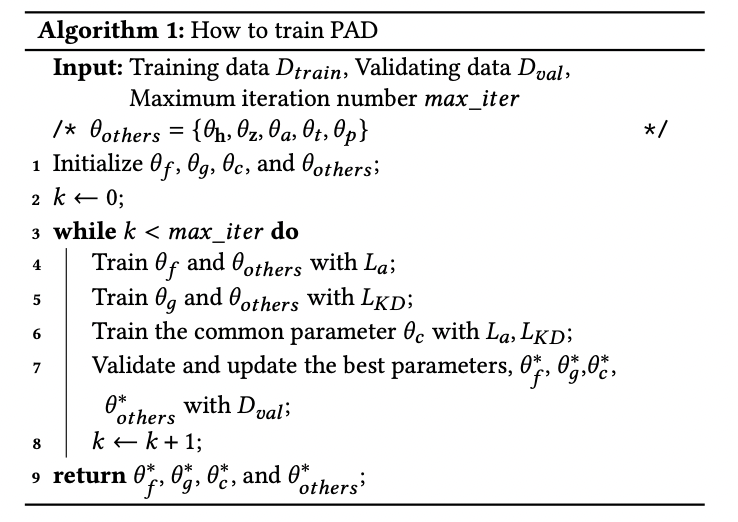
4. Experiments
(1) Regular TS
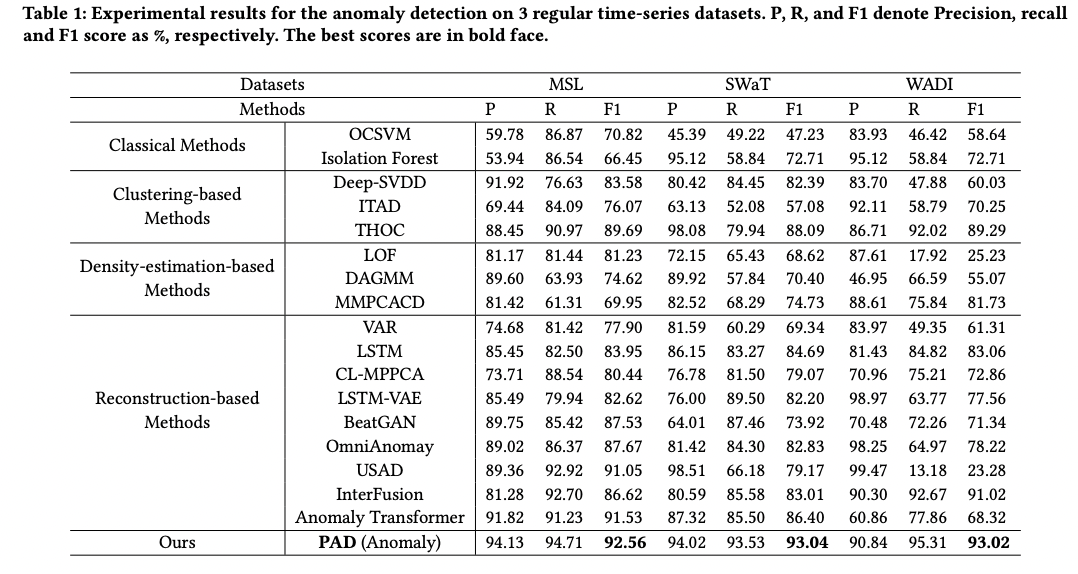
(2) Irregular TS
